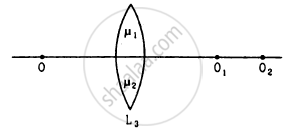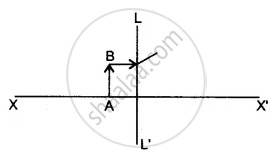Advertisements
Advertisements
प्रश्न
Match the following:
| Column - I | Column - II | ||
| 1 | Retina | a | Path way of light |
| 2 | Pupil | b | Far point comes closer |
| 3 | Ciliary muscles | c | near point moves away |
| 4 | Myopia | d | Screen of the eye |
| 5 | Hypermetropia | e | Power of accommodation |
उत्तर
| Column - I | Column - II | ||
| 1 | Retina | d | Screen of the eye |
| 2 | Pupil | a | Pathway of light |
| 3 | Ciliary muscles | e | Power of accommodation |
| 4 | Myopia | b | Far point comes closer |
| 5 | Hypermetropia | c | Near point moves away |
APPEARS IN
संबंधित प्रश्न
Define the power of a lens.
Consider two statements A and B given below:
A: real image is always inverted
B: virtual image is always erect
Out of these two statements:
What is the power of a convex lens lens whose focal length is 80 cm?
What is the nature of a lens whose power is, −4 D?
The focal length of a lens is +150 mm. What kind of lens is it and what is its power?
A combination of lenses for a camera contains two converging lenses of focal lengths 20 cm and 40 cm and a diverging lens of focal length 50 cm. Find the power and focal length of the combination.A optical instrument in which the above arrangement of convex lens is used is a convex lens used to burn paper by focusing sunlight.
Consider three converging lenses L1, L2 and L3 having identical geometrical construction. The index of refraction of L1 and L2 are \[\mu_1 \text{ and } \mu_2\] respectively. The upper half of the lens L3 has a refractive index \[\mu_1\] and the lower half has \[\mu_2\] following figure . A point object O is imaged at O1 by the lens L1 and at O2 by the lens L2placed in same position. If L3 is placed at the same place,
(a) there will be an image at O1
(b) there will be an image at O2.
(c) the only image will form somewhere between O1 and O2
(d) the only image will form away from O2.
A 5.0 diopter lens forms a virtual image which is 4 times the object placed perpendicularly on the principal axis of the lens. Find the distance of the object from the lens.
A diverging lens of focal length 20 cm and a converging lens of focal length 30 cm are placed 15 cm apart with their principal axes coinciding. Where should an object be placed on the principal axis so that its image is formed at infinity?
Complete the diagram to show the formation of the image of the object AB.

(i) Name the Lens LL’.
(ii) Where is the image of the object AB formed?
(iii) State three characteristics of the image.
